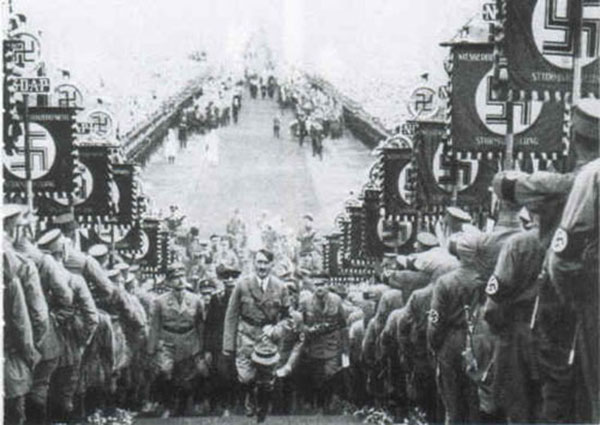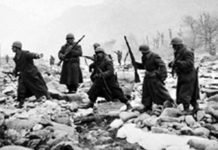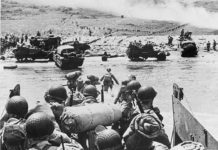Founded in 1919, the Nazi party remained until the loss of World War Two and Hitler’s suicide in 1945. Read on for a brief Nazi history.
The rise of Hitler and the Nazi party was gradual, but became alarmingly popular when Hitler was appointed Chancellor of Germany in 1933. The Nazi party seemed well organised and had extremely strong ideals which they defended with aggressive determination and force.
The Founding of the Nazi Party and the Rise of Hitler
In 1919 Anton Drexler, along with Gottfried Feder and Dietrich Eckart, founded the German Worker’s Party (DAP). As a spy for the German Army, Adolf Hitler attended one of their meetings in order to determine whether they were a left-wing revolutionary group and therefore a threat. During his attendance, Hitler discovered that despite being partly unorganized as a political party, the views they expressed were wildly similar to his own and stood up to express his opinions to an awed crowd.
Impressing Drexler in particular, Hitler was invited to join and after much deliberation eventually agreed, quickly becoming a valuable member of the party. In 1920 the group was re-named the National Socialist German Worker’s Party (NSDAP, later nicknamed the Nazi Party) and a the party drafted announced its 25-Point Programme, in which they refused to accept the terms of the Treaty of Versailles and insisted for the reunification of all Germans, presenting fierce racist and anti-Semitic views. In 1921 Hitler was pronounced party leader.
The Munich Putsch (Beer Hall Putsch) of 1923 and Changing Tactics for the Nazi Party
Up until 1923 the methods of gaining support were very much focused purely on violence. In September 1921 Hitler and a handful of other party members were sent to prison for violently attacking a rival politician, and when he was released formed his own private army named the Sturm Abteilung (SA, Storm Troopers or ‘brown shirts’) and instructed them to disrupt the meetings of political opponents and to protect Hitler from revenge attacks. Ernst Roehm, his Commanding Officer in the army, recruited the men and Hermann Goering, a former air pilot, became the leader.
The most organized attempt of violence was during a meeting held by the Bavarian government, which Hitler and the SA disturbed aggressively, demanding a reform of government. Despite Hitler’s meticulous organization, he failed to plan the control of radio stations and telegraph offices. The National government of Berlin soon gained knowledge of the Putsch and immediately gave orders for it to be crushed, succeeding so as the group marched through Munich. Found cowardly hiding in a friend’s house, Hitler was eventually arrested and put on trial for high treason, along with a few other party members.
Nazi sympathizers in the Bavarian government ensured that Hitler received only the minimum sentence, a mere five years of which he only served one year. Whilst in prison he wrote ‘Mein Kampf’ (‘My Struggle’), an autographical, political book that built the basis of propaganda and racist attitudes. It was in this text that Hitler wrote about altering tactics, most importantly about toning down, if only slightly, the violent means of gaining political support and deciding that travelling through the current political system using heavy propaganda would be the most effective method. In 1925 Hitler organized a party conference in Bamberg where it was decided that the party would be run according to the ‘Fuhrerprinkip’, a method in which the leader decided all.
Popularity of the Nazi Party in the 1920s
It became clear that Hitler and his astounding ability to consistently amaze large crowds of people through his influencing speeches was one of the most persuasive things that widened the Nazi party’s popularity. Hitler had also helped to create a far stronger identity for the once ‘unorganized’ group, including creating an established newspaper (‘Volkischer Beobachter’), a Nazi salute and a logo famously known as the Swastika. In 1925 the party had 27,000 members and by 1928 it had more than tripled to 108,000, despite only snatching 3% of the vote during German elections the same year.
The economic plummet caused by the Wall Street Crash in 1929 caused despair, most especially for Germany due to their heavy reliance on foreign loans, and Germans were desperate for a drastic change. Vast political maneuvering of leaders further increased the unreliable image of the standing government and Nazi organization and reformation plans suddenly appealed to the masses, making them the second largest political party in Germany in 1930. Support for the NSDAP fluctuated dramatically between 1931-33, peaking in July 1932 with 230 seats in the Reichstag. It was a year later that Adolf Hitler became Chancellor of Germany, replacing Kurt von Schleicher.
Nazi Ideology and Policy
Nazi ideals emphasized traditional values of family, desiring to build a ‘Nazi Volksgemeinschaft’ (community of pure Germans) that was self-sufficient (‘autarky’). Women were to follow the three ‘Ks’: Kinder, Küche and Kirche (children, kitchen and Church) but were strongly encouraged to marry only pure Germans; Hitler saw intermarriages, most especially with Jews, as the cause for the loss of the First World War and was jealous of their apparent business successes.
As a result, the first official boycott of Jewish shops took place on 1st April 1933, followed by the Nuremburg Laws in 1935 where it became illegal for Jews to marry non-Jews and they no longer held the right to vote. In November 1938 around 7,500 Jewish businesses and 200 synagogues were destroyed during ‘Kristallnacht’ (‘Night of Broken Glass’) and over 30,000 Jews were sent to camps. In 1941 Jews were forced to brandish yellow stars on their clothes, making them easily distinguishable and easier targets for abuse. In 1942, the Final Solution was disturbingly agreed.
Almost as soon as Hitler came into power, and partly thanks to the Reichstag Fire of 1933, all opposition parties to the NSDAP were banned and Germany became ruled by dictatorship. Germany was controlled vigorously by the Schutzstaffel (SS), a private group of bodyguards for Hitler established in 1925, and the knowledge gained from the Gestapo’s secret informers. The SS subsequently became responsible for the implementation of Nazi policy and ideology and controlled the state with fierce hostility. In June 1934, Hitler feared that the SA was a threat to his power and so the SS were used to murder SA leaders and arrest hundreds of members during the ‘Night of Long Knives’.
Hitler wanted to ensure that the following generation grew up with firm Nazi ideals, and so created the Teacher’s Association, which monitored and morphed the educational system to Hitler’s ideals, and the Hitler Youth.
Nazi Economic policy was to restore Germany to full employment and rearm the nation ready for war. Compared to the previous Weimar Republic it was evidently more successful, and more popular, although statistics were slightly manipulated.
Nazi control ended when Germany surrendered in World War II in 1945.
Reference:
- Spatacus Educational – Nazi Party (NSDAP)








